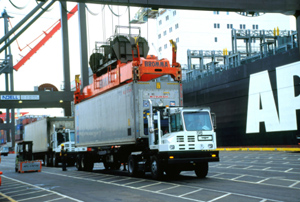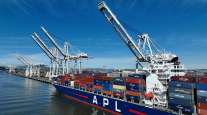Trucks Waiting Longer at Calif. Ports as Cargo Rise Hits Leaner Terminals

This story appears in the June 14 print edition of Transport Topics. Click here to subscribe today.
An increase in cargo traffic and warehouse staffing cutbacks at the ports of Los Angeles and Long Beach have left trucks at the ports waiting in longer lines to enter terminal gates, port officials said.
As a result, terminal operators are exploring the possibility of implementing an appointment system to ease congestion, especially during peak hours of 8 a.m. to 5 p.m.
Art Wong, a spokesman for the Port of Long Beach, likened the wait problem to a perfect storm. During the economic downturn, terminal operators reduced staffing levels, cut back the number of nighttime gates and shrank their hours of operation,
including closing down during the lunch hour. Now, with container traffic increasing, there is inadequate staff to keep up with the more energetic pace, Wong told Transport Topics.
Total container numbers at the Port of Los Angeles were up 9% through April from a year ago and more than 16% at the Port of Long Beach. As a result, Wong said, truckers are now complaining that the waits can be three hours or more.
Currently, only three of the 13 container terminals at the two ports require carriers to make appointments to pick up loads, said Bruce Wargo, chief executive officer of PierPass Inc., the Long Beach company that contracts with the terminals to operate the gates.
“Turn times inside the gates are fairly decent,” Wargo told TT. “The real issue stems from the fact that they’re waiting in the street.”
However, the reservation system has produced mixed results, Wargo said, because truckers sometimes show up too early, too late or not at all.
“A lot of the terminals have wait-time issues because truckers show up whenever they want, en masse,” Wargo said. “That becomes an issue because they’re expecting full and complete service any time of the day or night.”
Often paid by the load, drivers contend that long wait times cut into their pay and profits because the waits reduce the number of trips they can complete on any given day.
If the terminal operators agree, a larger appointment system could be put in place as early as August, Wargo said.
Wong said the ports are “encouraging” the terminals to take action to reduce the wait times but cannot force them to create an appointment system.
“The problem might take care of itself if the economy keeps picking up and they can bring more of these people back to work,” Wong said.
Phillip Sanfield, a Port of Los Angeles spokesman, said his port hopes to “facilitate” a solution to the wait-time problem. “But we’re letting PierPass take the lead,” he said.
The long wait times and other problems surfaced in Congress during a House Subcommittee on Highways and Transit hearing last month examining the effectiveness of the ports’ clean trucks plans aimed at reducing diesel emissions.
Subcommittee Chairman Peter DeFazio (D-Ore.) characterized the testimony at the hearing as “disturbing and contradictory,” indicating his committee will look further into problems in future months (5-10, p. 4; click here for story).
DeFazio said terminal operators have caused the problem because they have cut back on staffing at warehouses. He called cargo movement operations at the two ports inefficient, noting that “everything seems to be conspiring against the people who actually drive the rigs.”
Christopher Lytle, deputy executive director of the Port of Long Beach, acknowledged the wait-time problem and said the port is working with terminal operators on “several initiatives.”
“It’s critical for the truck drivers to be able to get multiple loads every day,” Lytle told the subcommittee.
John Holmes, deputy executive director of operations for the Port of Los Angeles, acknowledged that wait times have been increasing and called the development a “significant problem.”
“A properly run appointment system will not only spread out the traffic, but you’ll also be much more efficient,” Holmes said.
Craig Merrilees, a spokesman for the International Longshore & Warehouse Union, told TT that terminal operators are “causing big problems by reducing hours and closing gates during meal times.”
“These changes are unfair to the port drivers and local communities that are all being impacted by the unnecessary backups,” Merrilees said.
T.J. Michels, a spokeswoman for the Coalition for Clean & Safe Ports, an alliance of environmental, labor and community organizations that focus on West Coast ports, said the Southern California ports are not the only ones with long lines.
“Ports across the country are notorious for long wait times where polluting engines idle and pump deadly diesel into the air,” Michels told Transport Topics. “It is a double-whammy for the workers behind the wheel, who have to breathe toxic fumes and are not paid one penny for the time they spend in line.”




